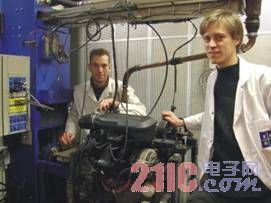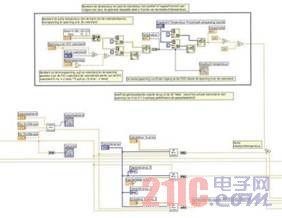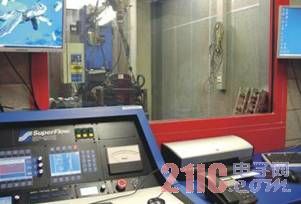“We designed a very flexible, programmable engine management system using the CompactRIO programmable automation controller, which is modular, expands additional sensors, and includes field-programmable gate arrays (FPGAs).â€
This article refers to the address: http://
challenge:
Develop an efficient, low-emission adaptive engine control unit (ECU) to control engines that operate with standard gasoline, hydrogen, syngas or fuel mixtures.
solution:
Simulate, test, and control the engine with NI LabVIEW FPGA Module and NI CompactRIO for dynamic adaptive control.
Engine control unit
The emergence of new fuels and more efficient use of fuels will reduce fuel consumption and emissions, and maximize fuel utilization, thereby powering the engine in a more sustainable way. Several ECUs extract data from revolutions per minute (rpm), issue a torque/throttle position or a push pressure request from the turbocharged engine, and determine the optimum ignition time or time period and optimum fuel injection amount and injection time. We also use additional parameters (such as engine temperature) to correct these parameters. For example, a cold engine requires more fuel mixture than an engine operating at normal operating temperatures.
Currently available programmable ECUs are not suitable for research because they have limited programming capabilities and they use a series of predefined input variables (sensors). We designed a very flexible, programmable engine management system using the CompactRIO programmable automation controller, which is modular, expands additional sensors, and includes field-programmable gate arrays (FPGAs). With an FPGA, the system can quickly respond and support graphical programming with LabVIEW. In addition, due to our previous research projects, engineers are also experienced in using graphical programming.
Engine sensor simulation
Before we actually connect the CompactRIO-based ECU system to the engine on the test bench, we must make sure everything is working. Therefore, we used analog sensors for the CompactRIO engine controllers, which were controlled by another stand-alone application based on LabVIEW and NI CompactDAQ to simulate the voltage and current signals generated by the normal use of the sensor. We have found that sensors connected to camshafts and crankshafts typically produce an unpredictable 80Vpp signal, while NI C Series output modules have a limit voltage of 60V. To better characterize this signal and save time, we connect a real sensor to the gears and motor, control the motor's revolutions per minute based on LabVIEW and CompactDAQ applications, and then we pass the real signal to the CompactRIO ECU.
Designing an ECU with CompactRIO
We used the LabVIEW FPGA Module to develop our ECU and implemented it using LabVIEW's CompactRIO. We create a table that uses the engine revolutions per minute and torque request as input values, and uses the LabVIEW VI to insert array functions to find the appropriate actuator parameters, such as ignition timing and fuel injection timing. We also collect sensor signals such as manifold air pressure (MAP) and engine temperature to correct the parameters. With the CompactRIO system, we can easily add more non-standard sensors to study and adapt to different engine and fuel types. CompactRIO uses an FPGA to obtain the angular position of the crankshaft and camshaft and generate actuator signals at the correct time.
In addition to standard engine parameters, we also plan to measure cylinder pressure and use this data as a closed loop control parameter in the engine controller to maximize engine efficiency. The mixture is preferably ignited at the highest pressure level to produce maximum power. First, we want to optimize the control of a normal 4-cylinder gasoline engine. By implementing fast and reliable FPGA response times, we can better control combustion to increase engine efficiency. In addition, we will test our test engines under variable load conditions to further improve our control algorithms.
Future development of ECU
Hydrogen is an environmentally friendly fuel because it does not produce carbon dioxide. We are working hard to adapt the ECU to control hydrogen fueled car engines. When hydrogen is used as the fuel, the hydrogen/air equivalence ratio should match the low torque to achieve complete combustion without any hydrogen or air remaining. However, at higher torques, the engine is preferably operated at a lean fuel mixture ratio by pressurizing excess air into the engine, which is also referred to as the lean burn principle.
In order to reduce nitrogen oxide emissions, the engine should not operate under a moderate proportion of fuel/air mixture. In this control strategy, we always open the throttle and use a high air/fuel equivalence ratio, and the required torque is controlled by changing the amount of fuel. However, when the torque required is greater than the torque that lean burns can provide, we must instead control the throttle and switch between the two control strategies. Currently, in addition to the BMW Hydrogen 7 engine control system, there are no other commercially available engine control systems that can switch between these two control strategies. We intend to implement an ECU with CompactRIO to switch our control schemes and provide commercially available systems to interested third parties.

We designed a flexible ECU to control the pilot fuel for gasoline fuel, using additional engine parameters for maximum combustion control.

CompactRIO provides a hardware platform for the engine controller; LabVIEW is used to analyze the signal and control the actuator.

Our test engine is embedded in a test rig that produces a constant load (constant torque) and measures the engine's speed, or produces a variable load and keeps the engine speed constant.
Folding LED Desk Lamp unlike traditional incandescent light, the new generation LED desk lamp emits a flicker-free light that is very close to natural daylight. This means better protection for your eyes, which is the main persuit of our research.
Why LED Desk Lamps and Table Lamps are Important
LED table lamps and desk lamps combine all of the favorable qualities of portable lamps with the benefits of LED technology to create new modern lighting designs that are unique, highly innovative, and practical. the use of LEDs in portable lamps has allowed for decorative, compelling designs to serve as part of the decor of the room as opposed to simply being an additional light source.
Folding LED Desk Lamp
Folding LED Desk Lamp,Folding LED Small Desk Lamp,Creative Folding LED Desk Lamp,Reading Folding LED Desk Lamp
Shenzhen Superlight Technology Co., Ltd. , https://www.superlighttech.com